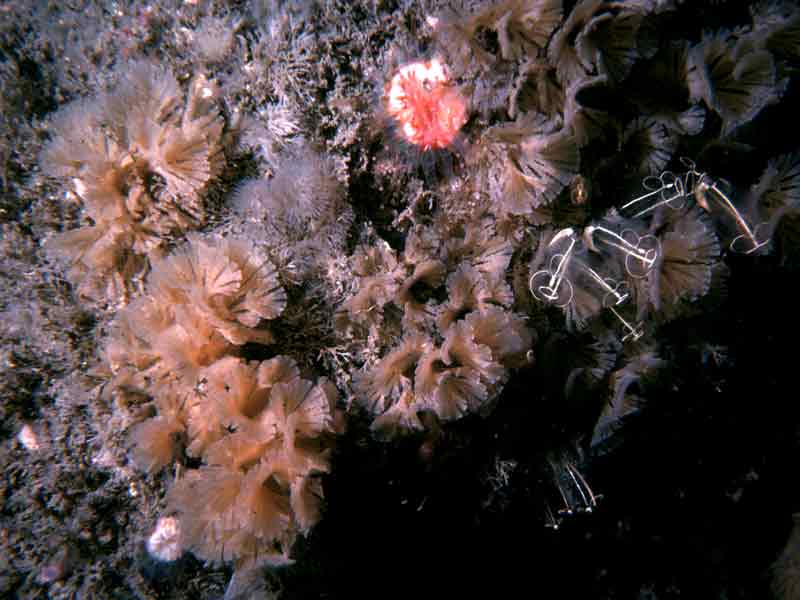An erect bryozoan (Bugulina flabellata)
Distribution data supplied by the Ocean Biodiversity Information System (OBIS). To interrogate UK data visit the NBN Atlas.Map Help
| Researched by | Susie Ballerstedt | Refereed by | Admin |
| Authority | (Thompson in Gray, 1848) | ||
| Other common names | - | Synonyms | Bugula flabellata (Thompson in Gray, 1848) |
Summary
Description
Recorded distribution in Britain and Ireland
Relatively common around the coast of Britain. Records are more abundant on the east coast of Ireland than the west coast.Global distribution
Extends from the North of Scotland to the Mediterranean.Habitat
Occurs on the lower shore and shallow sublittoral rocky shore. Usually attached to other bryozoan species such as Porella concinna, Schizomavella auriculata, Schizomavella linearis and Cellepora pumicosa, as well as the fronds of Flustra foliacea and the lobes of Alcyonidium diaphanum.Depth range
-Identifying features
- Colony erect, branching and attached by frontal, lateral and basal rhizoids.
- Colony 2-5 cm in height.
- Branches are broad, flat and wedge-shaped, arranged somewhat circularly.
- Buff colour when living, grey when dried.
- Marginal zooids bear 3 spines on outer distal corner, 2 spines on inner distal corner.
- Inner zooids bear 2 spines on both distal corners.
- Ancestrula has 3 proximal spines and a further 3 spines on each distal corner.
- Polypide has 14 tentacles.
- Ooecia are sub-globular and conspicuous.
Additional information
No text enteredListed by
- none -
Bibliography
Bruce, J.R., Colman, J.S. & Jones, N.S., 1963. Marine fauna of the Isle of Man. Liverpool: Liverpool University Press.
Hayward, P., Nelson-Smith, T. & Shields, C. 1996. Collins pocket guide. Sea shore of Britain and northern Europe. London: HarperCollins.
Hayward, P.J. & Ryland, J.S. (ed.) 1995b. Handbook of the marine fauna of North-West Europe. Oxford: Oxford University Press.
Hayward, P.J. & Ryland, J.S. 1998. Cheilostomatous Bryozoa. Part 1. Aeteoidea - Cribrilinoidea. Shrewsbury: Field Studies Council. [Synopses of the British Fauna, no. 10. (2nd edition)]
Hincks, T., 1880. A history of British marine Polyzoa, vol. I & II. London: John van Voorst.
Howson, C.M. & Picton, B.E., 1997. The species directory of the marine fauna and flora of the British Isles and surrounding seas. Belfast: Ulster Museum. [Ulster Museum publication, no. 276.]
JNCC (Joint Nature Conservation Committee), 1999. Marine Environment Resource Mapping And Information Database (MERMAID): Marine Nature Conservation Review Survey Database. [on-line] http://www.jncc.gov.uk/mermaid
Datasets
Fenwick, 2018. Aphotomarine. Occurrence dataset http://www.aphotomarine.com/index.html Accessed via NBNAtlas.org on 2018-10-01
NBN (National Biodiversity Network) Atlas. Available from: https://www.nbnatlas.org.
OBIS (Ocean Biodiversity Information System), 2024. Global map of species distribution using gridded data. Available from: Ocean Biogeographic Information System. www.iobis.org. Accessed: 2024-04-24
Citation
This review can be cited as:
Last Updated: 29/07/2004




